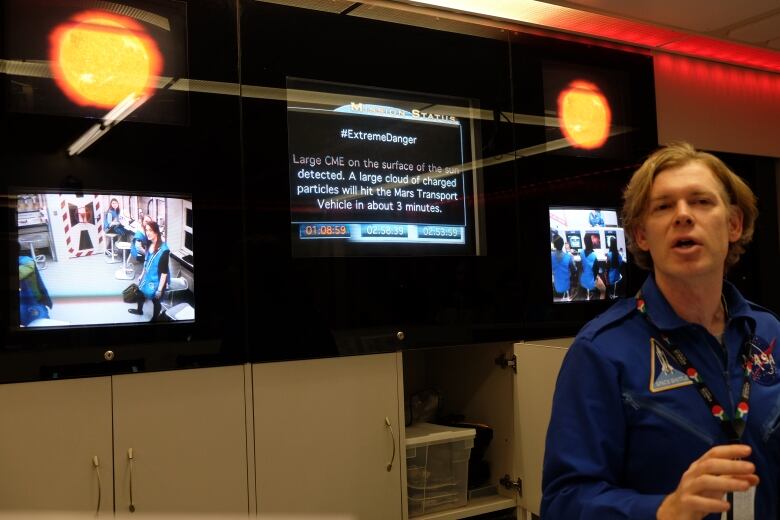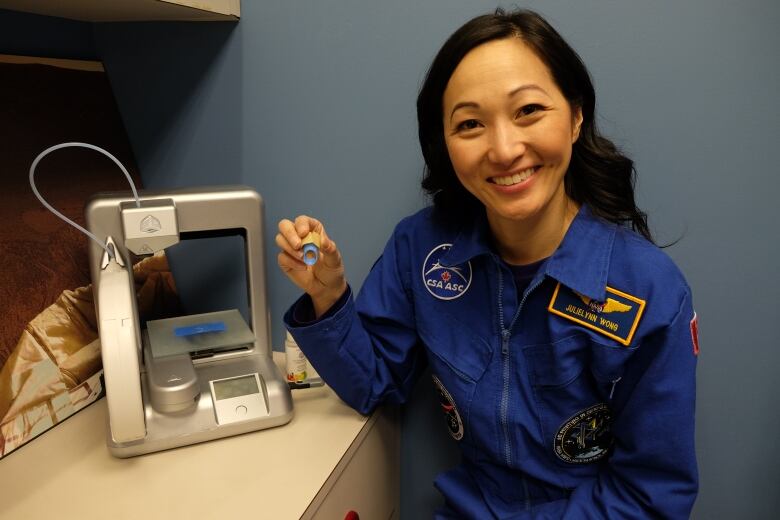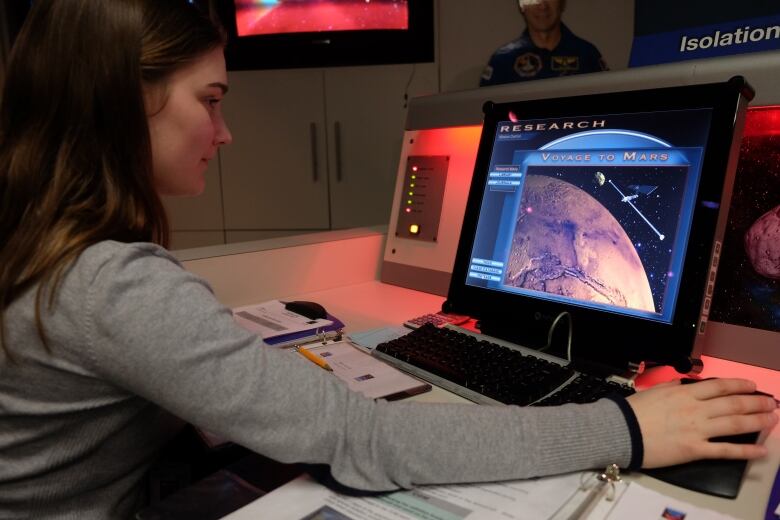Mars mission at Canadian space simulator gives taste of astronaut life
Ontario Science Centre's Challenger Learning Centre is unique in Canada
I'm on a spaceship that's just entered orbit around Mars when the lights dim,alarms blareand smoke starts spewing through the cabin. I jump from myworkstation, confused and anxious to knowwhat's going on.
"Who has a fire extinguisher?" barks our commander, Martin Fischer, gesturing toward an instrument panel at knee level. "Something just exploded in there."

OK, so I'm not actually in outer space.I'm on the Voyage to Mars at theChallenger LearningCentre at the Ontario Science Centrein Toronto.
It'sa space simulator that's unique in Canada and part of the legacy of theChallenger disasterin 1986,one of the biggest tragedies in the history of space exploration.Unlike other Mars simulations for scientists and astronauts, this one provides limited access to the public.
The program is designed to provide would-be astronauts with an educational and entertaining taste of modern space travel in replicasof a NASA mission control room and the inside of a spacecraft.
If you've ever wanted to visit Mars, this is aboutthe closest you can get right now or might ever get.
While the Mars One Project now says it aims to send humans on one-way trips to the Red Planetby 2027, experts, including former Canadian astronaut JuliePayette,say thetechnology won't be ready by then.
- JuliePayette, former Canadian astronaut, says Mars mission is going nowhere
- Mars One: 6 Canadians make short list for 1-way trip to Mars
- Mars One plan has potentially deadly flaws, scientists say
The world's space agencies currently aim to send astronauts to Mars after 2033, so a real baseon Mars won't be built anytime soon.
Journey to 2076
The crew I've joined is from the Ontario Science Centre's science school, which brings together up to 30 high school students at a time from around the province to complete Grade 12 science and math courses during a semester at the centre.
Our mission is set in the year 2076,when most of my fellow crew-mates will be 60years old.

Our mission is to navigate to Mars and replace a crew that has spent the last two years at a base on the Red Planet andiseager to return to Earth.
Each of us is assigned a job, from the "nav"team calculating a course for the spacecraft to a space weather team that keeps tabs on solar storms that could disrupt electronics and communications on board.
I'm assigned to a team operating a trio of robotic arms. My teammatesEllie Badun of Unionvilleand Eleonore Day of Etobicoke, both 17, are dealing with dangerous "radioactive" and "toxic" compounds. My job is to examine "solar panels" outside the ship to see how badly they'vebeen damaged by meteoroids.
There are constant interruptionsmessages from Mars Mission Control,radiation checks from the medical team and updates about potentially dangerous space weather.
Amid the distractions,usingtwo joysticks to manipulateso many rotating,bending joints and a hand is harder than it looks.I'm frustrated after clumsily dropping all three panels.
Blast of plasma
I've been embarrassingly unproductive by the time we count down before entering into a rumbling orbit around Mars.
It's shortly after that when the alarms go off andsmoke starts pouringthrough the ship. Acoronal mass ejection a blast of plasma from the sun has hit our ship and damagedour electronics.

Someone yanksa burned out component from the instrument panel while the communications officer sends a message to Mars Mission Control. There's no response we can no longer hear them and they can't hear us.
Fortunately, the Mars Mission Control teamcomes up with a clever solution. A memberappears on the video screen, holding up a slip of paper scrawled with the words: "Are you okay?" We scramble to write a response.
We communicate that way until our ship makes a harrowing near crash-landing on Mars (Thanks, Nav Team!) about 15 minutes later. Red lights blink, there's a whirring noise, and we enter the airlock to meet the crew at Mars Mission Control.
Challenger shuttle legacy
The science centre's Challenger LearningCentre is part of a network of 40 educational space simulators created in partnership with NASA by the families of the crew who died when the Challenger space shuttle exploded in 1986. The mission featured a "Teacher in Space" educational component and one crew memberwas Christa McAuliffe, a high school teacher from Concord, New Hampshire.
- Marc Garneau speaks about the Challenger disaster
- 28 years later: CBC readers recount Challenger tragedy
Most of the simulators are in the U.S. The one at the Ontario Science Centre opened in 1992, and was rebuilt about nine years ago. It's hidden behind unmarked doors in a hallway at the back of the centre and isn't open to ordinary visitors.
About 6,000 to 9,000 students and a handful of corporate groups take part in the program each year. The science centre charges $15 per student and a minimum of $62.50 per corporate employee.

Some aspects of the simulation are clearly unrealisticwe experience fullgravity, the trip doesn'ttake the better part of a yearand there are no communications delays between Earth and Mars. But the details, from the in-ship lighting to the graphics of Mars appearing on our screens, are still impressive.
The simulation does a good job of conveying some aspects of space missions the emphasis on procedures andcommunications that are funnelled through one point of contact, and the constant activity, problem solving and teamwork that make upan astronaut's day.
Each mission crew faces different problems and new activities are constantly added to keep the program fresh, saysTeressa Black, lead flight director for the centre.

"We try to parallel what's going on in the real space program," she says.
In fact, the day wevisited, the program debuted an activity in which the crew at mission control on Mars had to 3D print a custom finger splint using a real 3D printer. Toronto doctor and 3D printing expert Julielynn Wong designed the module for the centre after a 3D printer was sent up to the International Space Station.
But the reality is thatVoyage to Mars is more a simulation of space travel today thanspace travel in 2076.
When the simulationfinally ends with the successful departure of the new Earth-boundcrew, everyone applauds loudly and smiles light up their faces.
"That was amazing," saysBadun, adding that she felta real sense of accomplishment when the mission was complete.
Daysaysshe learned a lot about space missions from the experience.
"There's so much organization that goes into it ...And there's so many things that can go wrong."
While we learned some science concepts about the effects of solar storms and the nature of Mars's moons, the emphasis of the simulationwas more on teamwork and problem-solving.
Still, the experience felt impressively real to me.I leftfeeling I hada better sense of what space missions are like but that I need to work a lot harder on my robot-operating skills before I'm ready to become a real astronaut.
Videos produced by Janet Thomson and Manmeet Ahluwalia, CBC News















_(720p).jpg)


 OFFICIAL HD MUSIC VIDEO.jpg)
.jpg)



























































































